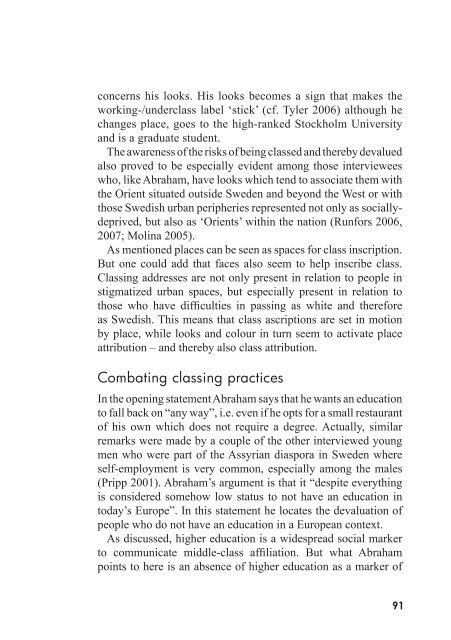Thinking with Bevereley Skeggs - Stockholms universitet
Thinking with Bevereley Skeggs - Stockholms universitet
Thinking with Bevereley Skeggs - Stockholms universitet
- No tags were found...
You also want an ePaper? Increase the reach of your titles
YUMPU automatically turns print PDFs into web optimized ePapers that Google loves.
concerns his looks. His looks becomes a sign that makes theworking-/underclass label ‘stick’ (cf. Tyler 2006) although hechanges place, goes to the high-ranked Stockholm Universityand is a graduate student.The awareness of the risks of being classed and thereby devaluedalso proved to be especially evident among those intervieweeswho, like Abraham, have looks which tend to associate them <strong>with</strong>the Orient situated outside Sweden and beyond the West or <strong>with</strong>those Swedish urban peripheries represented not only as sociallydeprived,but also as ‘Orients’ <strong>with</strong>in the nation (Runfors 2006,2007; Molina 2005).As mentioned places can be seen as spaces for class inscription.But one could add that faces also seem to help inscribe class.Classing addresses are not only present in relation to people instigmatized urban spaces, but especially present in relation tothose who have difficulties in passing as white and thereforeas Swedish. This means that class ascriptions are set in motionby place, while looks and colour in turn seem to activate placeattribution – and thereby also class attribution.Combating classing practicesIn the opening statement Abraham says that he wants an educationto fall back on “any way”, i.e. even if he opts for a small restaurantof his own which does not require a degree. Actually, similarremarks were made by a couple of the other interviewed youngmen who were part of the Assyrian diaspora in Sweden whereself-employment is very common, especially among the males(Pripp 2001). Abraham’s argument is that it “despite everythingis considered somehow low status to not have an education intoday’s Europe”. In this statement he locates the devaluation ofpeople who do not have an education in a European context.As discussed, higher education is a widespread social markerto communicate middle-class affiliation. But what Abrahampoints to here is an absence of higher education as a marker of91
















